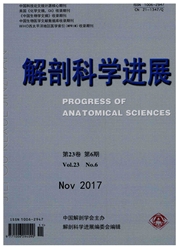

 中文摘要:
中文摘要:
目的观察创伤后应激障碍(PTSD)大鼠杏仁核神经元细胞色素氧化酶(COX)及Caspase3mRNA的表达变化,进一步认识PTSD行为异常的神经生物学机制。方法采用国际认定的连续单一刺激(single prolonged stress,SPS)方法建立大鼠PTSD模型,取成年健康雄性Wister大鼠40只,随机均分为PTSD模型的1d、4d、7d组及正常对照组。应用酶组化检Ncox的表达,采用逆转录-聚合酶链式反应(RT—PCR)技术检测细胞色素氧化酶Ⅱ亚基(COⅡ)及Caspase3mRNA在PTSD杏仁核神经元的表达。结果PTSD大鼠杏仁核神经元细胞质内COX活性和COⅡmRNA表达水平明显低于正常对照组,SPS7d时最低。Caspase3mRNA表达于SPS刺激后逐渐上调,于SPS7d时表达最高。结论创伤后应激障碍模型大鼠杏仁核COX,COⅡ及Caspase3可能与PTSD的发病机制有关。
 英文摘要:
英文摘要:
Objective To observe the expression of cytochrome oxidase(COX) and Caspase 3 mRNA in the amygdala neurons of posttraumatic stress disorder(PTSD) rats to explore the neurobiological mechanism of PTSD. Methods The single prolonged stress(SPS) method was used to set up the rat PTSD models. A total of 40 male Wistar rats were randomly divided into ld, 4d, 7d of SPS groups and normal control group, enzymohistochemistry was used to detect the activity of COX and RT-PCR was used to detect the expression of COⅡ- and Caspase 3 -mRNA. Results The activity of COX and the expression of COⅡ mRNA in amygdala neurons gradually decreased at 1d, 4d and 7d after exposure to SPS compared with the control group, reached the minimum at SPS 7d after exposure to SPS, however the expression of caspase 3 mRNA increased and reached the maximum at 7 day after SPS stimulation. Conclusion COX, COⅡ and caspase 3 may be related to the pathogenesis of PTSD.
 同期刊论文项目
同期刊论文项目
 同项目期刊论文
同项目期刊论文
 Single-prolonged stress induces apoptosis in the amygdala in a rat model of post-traumatic stress di
Single-prolonged stress induces apoptosis in the amygdala in a rat model of post-traumatic stress di Activitity of the 5-HT 1A receptor is involved in the alteration of glucocorticoid receptor in hippo
Activitity of the 5-HT 1A receptor is involved in the alteration of glucocorticoid receptor in hippo Increased phosphorylation of extracellular signal-regulated kinase in the medial prefrontal cortex o
Increased phosphorylation of extracellular signal-regulated kinase in the medial prefrontal cortex o Changes of Bax, Bcl- 2 and apoptosis in hippocampus in the rat model of post-traumatic stress disord
Changes of Bax, Bcl- 2 and apoptosis in hippocampus in the rat model of post-traumatic stress disord 期刊信息
期刊信息
